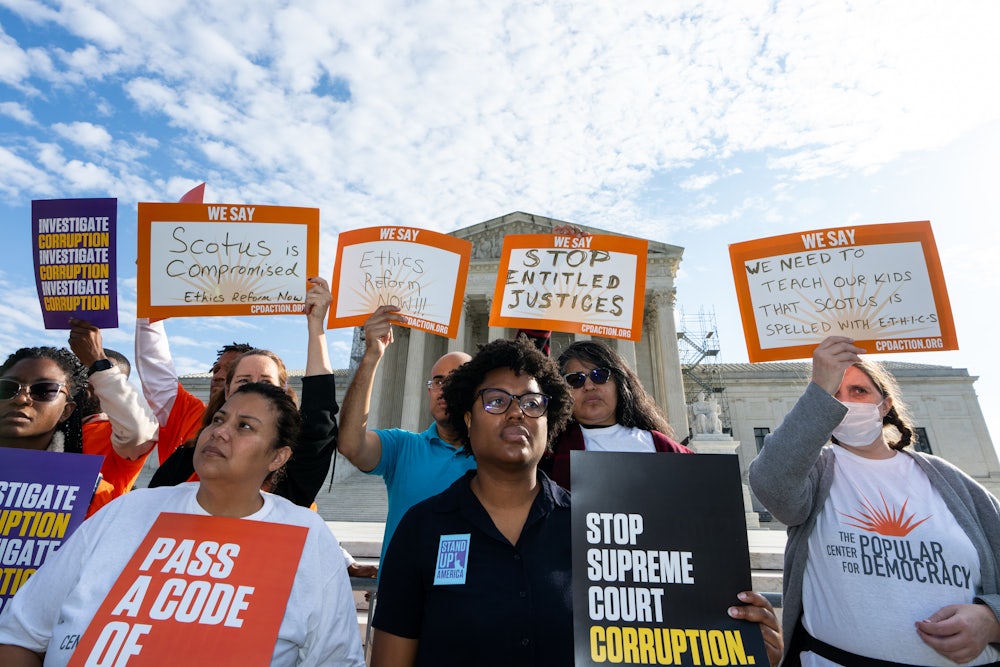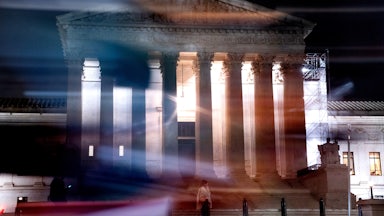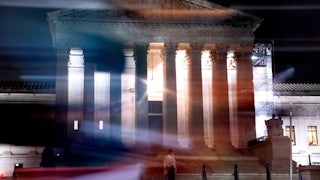The Supreme Court is starting its latest term under one of the darkest clouds of its history, with polls showing public confidence in the court near historic lows. The justices themselves have mostly stayed silent on the matters that brought them to this lowly state. While they have given the occasional speech and have written a few public letters, they have made no attempt to explain why, for example, Justice Clarence Thomas failed to recuse himself from a January 6 records case that implicated his wife’s communications. And it’s not only Thomas. Justices Sonia Sotomayor and Neil Gorsuch failed to recuse themselves from cases involving their own book publisher. (The Supreme Court said this was an “inadvertent omission.”)
But now, a case has arrived at the high court that asks the justices to decide whether a federal judge—or a justice—must recuse from a case whenever the judge’s impartiality is reasonably in doubt. The justices will meet next Monday to discuss whether to take the case. If they do, they will have a chance to lay down a clear rule about when the appearance of a conflict of interest is enough to require recusal. If they don’t take the case, that decision may speak just as clearly about the court’s views on judicial ethics.
A group of legal ethics experts has warned the Supreme Court that letting the lower court’s decision stand “would lead the public to believe that judges can decide cases even if, objectively, their appearance of impartiality could be questioned.
“The message this decision sends would greatly harm the public perception of the fairness of the judiciary,” these experts said in a friend of the court brief.
The case involves a Guantánamo prisoner and his attempts to overturn his conviction. But the law and the principles involved apply just the same to all federal cases in any court. The central question: When must a judge recuse under a law that requires recusals from “any proceeding in which his impartiality might reasonably be questioned”?
The case is brought by Ali Hamza Ahmad al-Bahlul, who has been held at Guantánamo since 2002 and is described by the government as Osama bin Laden’s P.R. manager. Bahlul was convicted of conspiracy to commit war crimes and sentenced to life imprisonment.
When he appealed, one of the judges assigned to the case was Gregory Katsas—a man with whom he shared a substantial history. Before Katsas became a judge, he worked for the Justice Department litigating against many Guantánamo detainees, included Bahlul. Katsas described himself at the time as “captain of the Department of Justice javelin-catching team,” fending off the legal attacks launched by detainees. When Bahlul and other prisoners filed suit in 2008 to try to stop their prosecution, Katsas was one of the prosecutors lined up against them, fighting to keep them imprisoned and the prosecutions moving ahead. Later, the future judge publicly praised the Guantánamo prosecutions’ legality and effectiveness, saying that Bahlul’s prosecution in particular “worked well” and noting it ended with a life sentence.
Bahlul asked the judge to disqualify himself from the case, but Katsas refused, reasoning that the 2008 case was distinct from this one. Now Bahlul is asking the Supreme Court to decide whether the law requires the judge’s disqualification.
The Supreme Court is scheduled to decide whether to take the case when it meets Monday for the first conference of its new term, which comes as the justices continue to face myriad ethical questions of their own.
The high court’s spotty-at-best record on ethics has taken a toll. A Gallup survey last year found just 9 percent of Americans said they had a “great deal” of confidence in the Supreme Court and the federal judiciary—and 51 percent had little or no confidence. Five years earlier, in 2018, only 31 percent said they had little or no confidence in the court.
This collapse in public regard did not happen in a vacuum. Indeed, a regular drumbeat of revelations about justices’ behavior has kept the court’s ethics in the spotlight. Justice Thomas accepted dozens of luxury trips and hundreds of thousands of dollars in gifts from conservative billionaire Harlan Crow without disclosing them. (Thomas says the two are friends.) Flags with conservative meanings were flown outside Justice Samuel Alito’s home and beach house, apparently by the justice’s vexillophile wife. Justice Sotomayor’s court staff urged libraries and colleges to buy her book.
And there have been plenty of recusal issues. Among them, Justice Thomas failed to recuse himself from a case about whether records from the Trump White House had to be turned over to January 6 investigators—even though the justice’s wife, Ginni Thomas, had been frequently communicating with Trump officials about the “Stop the Steal” effort and may have been included in the documents. Thomas was the only justice to dissent from requiring the records’ disclosure.
The high court released a new code of conduct late last year that says a justice “should disqualify himself or herself in a proceeding in which the Justice’s impartiality might reasonably be questioned.” But the same section emphasizes that each justice “is presumed impartial and has an obligation to sit unless disqualified” and that the “rule of necessity”—the need to have enough justices to decide a case—“may override the rule of disqualification.”
The code of conduct only applies to the Supreme Court, not to lower courts, where considerations around recusals are somewhat different. A Supreme Court justice who decides not to hear a case cannot be replaced by anyone else, so a recusal leaves the court shorthanded. By contrast, when a lower court judge recuses, another judge takes over the case.
Even so, the Supreme Court’s code of conduct likely affects judges at every level, according to Charles Geyh, a professor at Indiana University Maurer School of Law who has long studied judicial ethics. He said the justices in their new code “bend over backwards to marginalize disqualification.”
“There’s a signaling that goes on to the lower courts that real judges don’t disqualify except in extreme cases,” said Geyh, who was one of the signatories on the friend of the court brief by ethics experts. “And I think in some ways it’s driving judges to make decisions in these marginal cases that run risks of harming the public’s confidence in the judiciary.”
The Bahlul case highlights how technical legal reasoning about recusals can obscure larger issues about judicial impartiality.
The long legal trail of the case dates back to 2002, when Bahlul was brought to Guantánamo and, he says, tortured to force him to confess to having ties to terrorism. When he and other detainees filed a habeas corpus petition to challenge their detention and prosecution in 2008, one of the Justice Department lawyers arguing against them was future judge Gregory Katsas. For years, Katsas was outspoken in support of the Guantánamo prosecutions and against Bahlul’s claims. Katsas testified to Congress that detainees like Bahlul should be barred from filing habeas petitions to challenge their prosecutions “to ensure that the trials move forward so that terrorists can be brought to justice.” He spoke at public events where he praised the military commissions’ rules. He said that Bahlul’s prosecution “worked well.”
Now, after being convicted by a military commission based largely on statements he says were elicited by torture, Bahlul is appealing the conviction, raising some of the same arguments he did in his habeas petition years ago. But in the intervening time, President Donald Trump nominated Katsas for the D.C. federal appeals court; Katsas was assigned to the three-judge panel hearing the appeal. Bahlul asked him to recuse himself, given his past public statements and the fact that Katsas personally fought Bahlul on the same issues years ago. But Katsas denied the recusal motion.
At issue is a law that says a judge (or Supreme Court justice) must recuse from “any proceeding in which his impartiality might reasonably be questioned.” Another section of the same law says judges must recuse if they previously served as a government lawyer in the same “proceeding” or “expressed an opinion concerning the merits of the particular case in controversy.”
Katsas decided that he did not have to recuse under that second section because he was not a government lawyer in the same case or proceeding, reasoning that Bahlul’s habeas corpus case was distinct from his present appeal. And, crucially, Katsas held that the two parts of the law are mutually exclusive—so if his prior government service doesn’t require him to recuse under the second section, then his prior service also cannot serve as the reason that his “impartiality might reasonably be questioned” under the first section. In other words, unless he was a government lawyer in the exact proceeding that comes before him, then his work for the government can never force him to recuse.
Katsas explained that the “impartiality might reasonably be questioned” language is found in “a more general ‘catch-all’ provision, so we should not lightly use it to shift the lines specifically drawn” in the section that gives more specific rules about government service. “At most,” he wrote, recusals under that “catch-all” provision “should occur only in ‘rare and extraordinary circumstances’”—quoting a decision written by Justice Brett Kavanaugh when he was a lower court judge.
Katsas’s decision also emphasized the differences between Bahlul’s habeas petition and his current appeal. “This proceeding is not that one, and it involves no direct, collateral, or any other review of that case,” he wrote. “I never appeared as counsel in either Bahlul’s underlying prosecution or the ensuing proceedings for judicial review. I never supervised either the prosecution or the review proceedings. I never expressed an opinion on the merits of the prosecution or the review proceedings.” He also noted he has recused himself from other Guantánamo cases in which he had been personally involved.
The government, in a brief urging the Supreme Court to decline to take the case, also pointed out that after Katsas declined to recuse, Bahlul’s conviction was affirmed unanimously by the three-judge panel—so even if Katsas had recused himself, the other two judges on the panel would still have been enough to affirm the conviction.
But Gabe Roth, executive director of the advocacy group Fix the Court, said Katsas’s reasoning was too technical and missed the point of the recusal law. “This is a really semantic thing that would not hold up in the court of public opinion, which is the court that counts when it comes to bias,” he said.
Bahlul’s petition to the high court makes a similar point, arguing that it is a “commonsense notion that judges should not hear a case involving the same parties, same facts, and same issues as a case in which they appeared as government counsel.” It said that the two parts of the law are not mutually exclusive, so even if Katsas’s work as a prosecutor in the habeas case did not disqualify him, he still should have recused because “his impartiality might reasonably be questioned.”
In other words, what should count is whether a judge appears to be impartial, not whether the narrower rule about prior government service is technically met.
“This devolves into an argument about how many angels are dancing at the end of a pin. It’s a very precise, narrow thing,” Geyh said of the judge’s reasoning. “But what’s driving this is something more elemental. We’re looking at the ability of litigants to get a fair shake in court. When the former prosecutor who was against them in an earlier stage of the litigation is the judge, it prevents them from getting a fair shake.” With the matter now before the Roberts court, the justices will have the chance to show how much weight they give to the appearance of fairness, and maybe start to turn the tide of public distrust in the federal judiciary.










